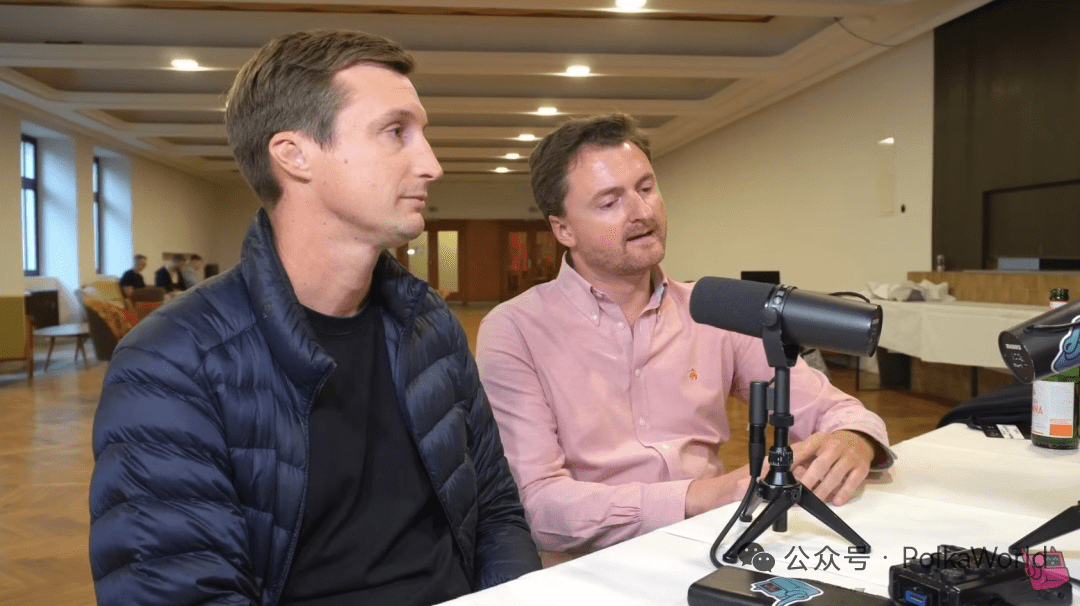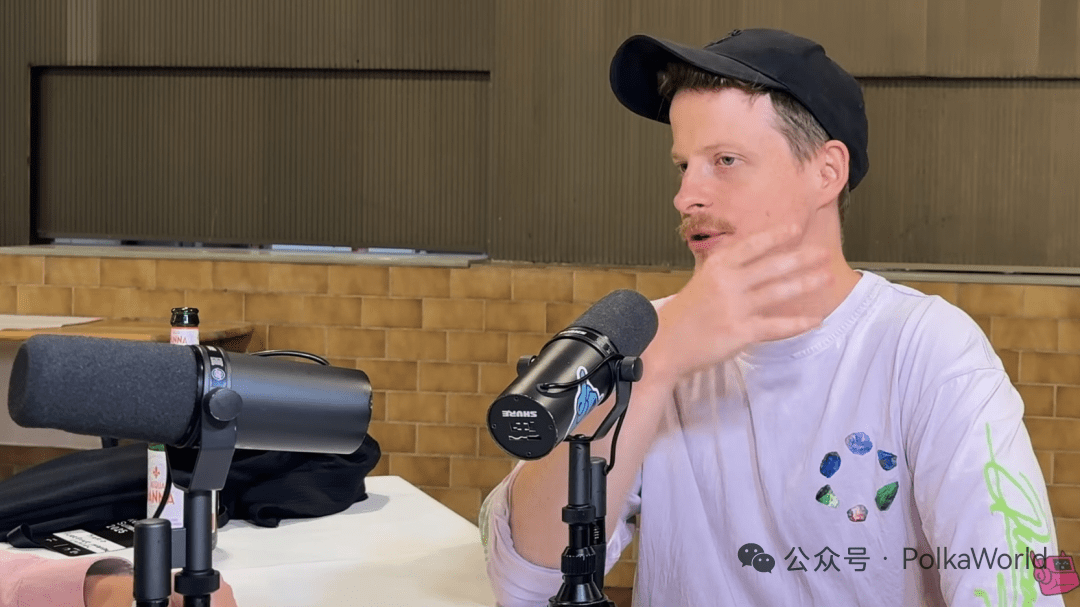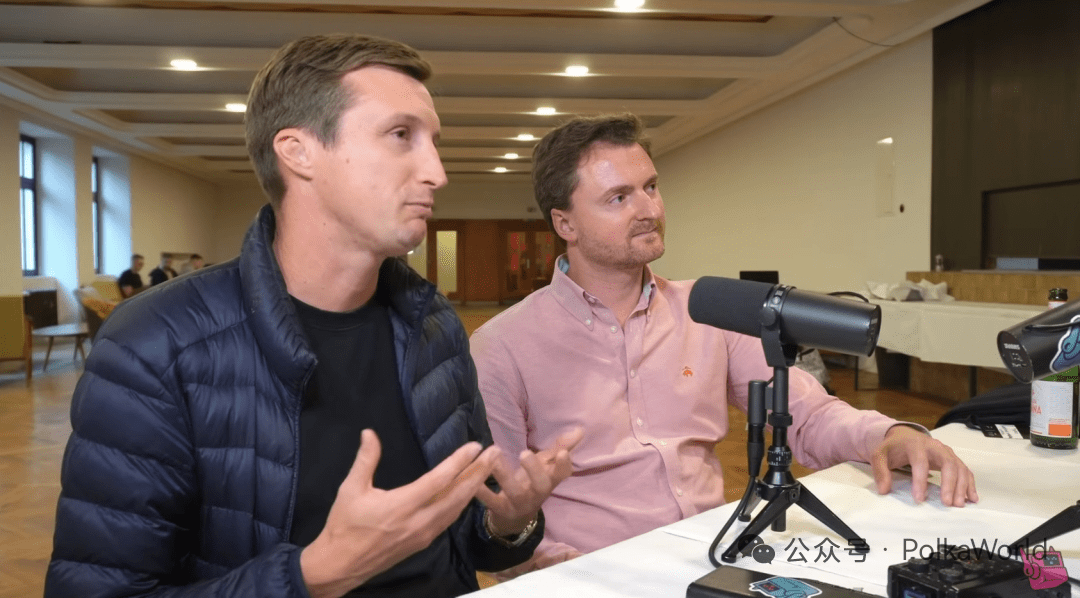
In the Polkadot ecosystem, there is a type of investor that does not just 'throw money' but uses capital to leverage applications, activate on-chain liquidity, and tell the ecosystem's story to global investors.
Harbor Industrial Capital (HIC) is such an entity.
From the first phase fund established in 2022 to the current second phase fund backed by the Web3 Foundation as the first LP, HIC has not only invested in star projects like Peaq, Mythical Games, Mandala, and Xcavate but also personally run nodes, acted as LPs, and participated in liquidity pools to activate DOT assets.
In their eyes, Polkadot is standing on the eve of a 'Cambrian explosion'—the Polkadot Hub is about to launch, JAM upgrades have not yet been priced into the market, and the potential of tracks like RWA, gaming, and government services is 'ceiling-level,' while Asia is the next growth engine.
In this dialogue (Space Monkeys), the two partners Mario Altenburger and Max Rebol shared their investment logic, pitfalls learned, observations on the Asian market, and why the funding narrative for Polkadot needs to shift from 'subsidies' to 'investments.'

Not just investing money: HIC Phase II brings funds, applications, and liquidity into Polkadot.
Jay: You are preparing the second fund; compared to the first fund, what are the different strategies this time?
The first phase was a purely private fundraising fund, with the main investors being family offices and institutional investors from Hong Kong and other parts of Asia.
And for the second phase of the fund, the Web3 Foundation is also an LP, and the first LP, which makes us a more 'official' ecosystem fund. Of course, we will still bring in funds from external institutions and family offices.
Jay: Is there any change in terms of geography? Last time you mainly focused on Asia; will you expand this time?
Mario: Actually, the project itself is global. In the first phase of the fund, we supported a total of 23 projects that secured parallel chain slots in the auction, and we also invested in some venture capital projects like Mythical Games.
The difference in the second phase is that there are no more slot auctions, so it will focus more on VC investments; meanwhile, it will activate token assets to let them function in the secondary market, such as joining liquidity pools (like Hydration), to enhance the liquidity of the entire ecosystem, which is part of a dual strategy. Additionally, we will also deploy nodes using tokens; for example, on Peaq Network, we run two nodes to support project development from a long-term holding perspective.
Jay: So you do not just invest money, but also actively manage the assets. The previous Crowdloan was indeed a good direction.
Max: Yes, we initially started with Crowdloan. Peaq Network can be considered one of the most successful cases. We supported them through Crowdloan, and the returns were quite good. It's exciting to have Peaq Network join the Polkadot ecosystem, even though Peaq doesn't emphasize its identity as a Polkadot project, they are indeed using Polkadot's technology and purchasing Coretime with DOT.
Jay: That's right; they are indeed very cutting-edge in technology. I saw that they are testing 'elastic scaling,' and the block time seems to have shortened to 0.4 seconds, which is quite amazing. Peaq is indeed a great case.
Mario: Yes, Mythical Games is also one of our very successful investments, and we have a lot of confidence in them. They just launched a new FIFA game, and it had 700,000 downloads within a few weeks, which is very successful.
In the second phase fund, we also invested in Mandala. Last year, we helped them secure a parallel chain slot, and now we have led their Pre-Seed round. We are optimistic about their layout in Indonesia—from government services (identity verification, healthcare, transportation) to bringing in private enterprises, this could be a disruptive change for Southeast Asia. They have also signed contracts with another country, but we can't disclose that yet, but it’s definitely big news.
Max: We believe Mandala is very likely to become the next peaq in the Polkadot ecosystem, whether in terms of value accumulation or on-chain activity. Of course, in the first phase of the fund, we also had some good investments like Litentry, which performed well. As for the second phase of the fund, we now have Mandala and just officially announced the investment in Xcavate—Richard and Alex are working on a very interesting project that tokenizes real estate in the UK, and they are currently applying for a UK FCA license. We believe this is the trend of the future, which can truly help the public enter the real estate market.
Jay: This use case has actually been discussed for a long time, but it’s really nice to see it being implemented so professionally now.
Mario: Yes, with technical experts like Richard and real estate specialists like Alex, I think this is a very good application scenario.
Max: Yes. Overall, we feel that the Polkadot ecosystem needs more applications to build, especially after the Hub launches, there needs to be a 'Cambrian explosion' of new applications flooding into the Hub, developing and growing rapidly. Of course, these teams all need financial support, right? So we at Harbor Industrial are also working hard to position ourselves as lead investors for these promising, commercially capable projects.
Mature projects should not continue to rely on treasury subsidies.
Max: Additionally, I think the narrative of the Polkadot ecosystem also needs to shift—from 'subsidies' to 'investments.'
Subsidies (grants) are certainly valuable; for example, when a founder graduates from PBA and starts a project, receiving some subsidies for startup capital is a good thing.
But when projects enter a growth phase or expansion phase, they should rely more on investment rather than subsidies. If you look at the current OpenGov, you will find that many projects applying for treasury funds are actually already commercially viable. But any funding applications through OpenGov are essentially subsidies without return requirements.
Jay: I thought of WAGOI.
Max: Yes, WAGOI is a good example, and Pixel Proof is too. These projects are great, and I like them, but they shouldn't rely on subsidies; they should finance through VC funds or ecosystem funds. The distinction is simple: investment will exchange for tokens or equity (I am broadly combining them here), whereas subsidies do not provide returns. I often ask these founders: when you apply for funding from the treasury, would you be willing to exchange some equity or tokens? They almost always say 'of course we would,' since they are just starting out and this is exactly what they want.
But unfortunately, there is no such mechanism at the moment. As an ecosystem fund, we can certainly invest, but the scale is still relatively small. If we can grow as expected in the future, we will be able to invest in these projects earlier and help them scale quickly. Because as VCs, we are putting in 'real money,' we hope for their success and will do our utmost to support them.
From hiking to fund partners: How two Austrian investors bet on Polkadot.
Jay: Do you also hold DOT yourselves?
Mario: Of course there is. The strategy for the first phase of the fund was: we invested our own money while attracting funds from about 50 LPs (family offices and 111 individual investors), then we bought DOT and used these DOT to participate in auctions. So the first phase of the fund still has a considerable reserve of DOT, which has already been deployed on Hydration.
Jay: GigaDOT?
Mario: Yes, GigaDOT.
Jay: Do you use leverage?
Max: We won't over-leverage, haha, we will still do risk management. But we will indeed use GigaDOT and participate in the liquidity activities of Hydration because we have a large DOT position, so we hope to achieve the best returns. I'm glad to see this activity running smoothly, and we are indeed involved.
Jay: And this can also help increase liquidity for Hydration, which is great.

Mario: Yes. The second phase fund may also have DOT positions, but the main goal is to directly invest funds into founders, focusing on directly supporting projects; the strategy will be a bit different.
Jay: How did you two meet and start collaborating?
Max: We are both Austrians but met in Hong Kong 11 years ago. I have lived in Hong Kong for 11 years, and Mario has lived there for 15 years.
Jay: So what was the reason you moved there in the first place?
Mario: Mainly for work. At that time, after finishing my master's degree at Columbia University, the Bank of China was looking for someone to help them expand their international capital market business, such as financing international companies with RMB. Later, we expanded our product range to convertible bonds, such as the Cathay Pacific project, etc.
At that time, I got to know Max, who was at Morgan Stanley and Deutsche Bank, primarily responsible for research and due diligence. I felt that our skills were very complementary.
Jay: I see, so you also moved there for work?
Max: Yes. I have been in Greater China for 15 years; I did my PhD in Shanghai and then moved to Hong Kong, where I first worked at a research company, then at Morgan Stanley and Deutsche Bank, primarily doing research work. About 10 years ago (2015), I got into Bitcoin through the Bitcoin community in Hong Kong. At that time, the Bitcoin circle in Hong Kong was very active, and I invested a little—of course, not enough, haha—but at least since then, I have been actively following this field. Later, I also bought Ethereum early, and then when Gavin left Ethereum to found Polkadot, he also did roadshows promoting Polkadot privately, going to Beijing, Shanghai, and also to Hong Kong. It was during that time that I met him and heard his vision for Polkadot, which resonated with me, so I also invested a bit in the private fundraising. That investment worked out well, but I was still working at Morgan Stanley at the time.
But since then, my focus has increasingly shifted to the crypto field, especially Polkadot. At that time, it was during the pandemic, and we could only hike in the countryside parks of Hong Kong, chatting as we walked, and discovered that many investors were interested in Polkadot, but very few truly understood it. So we thought, why not establish a fund to accept private investors' funds specifically to invest in projects within the Polkadot ecosystem.
Jay: That's impressive. So you started preparing in 2021 and then launched the first phase fund?
Mario: The first phase fund was established in January 2022, but we had started investing in Polkadot privately long before that. What attracted me was Max telling me a lot about the crypto field; he even advised me to buy Ethereum back in 2017, and that investment was quite successful.
But when I heard the story of Polkadot, I really felt 'wow, this is so different.' You see, it has a very reliable founder, Gavin, who is a co-founder of Ethereum and its CTO, wrote the technical white paper, built the Ethereum Virtual Machine, and has a solid technical background; the team he leads is also very strong, and their vision is to create a system that can truly be implemented to serve real-world applications and ordinary people. This really touched me.
"JAM hasn't been priced into the market yet."
Jay: You just mentioned JAM, do you talk about JAM when discussing investments with outsiders? Do you tell investors about the future prospects in this area?
Max: Absolutely. I am very optimistic about JAM, often saying 'JAM hasn't been priced into the market yet.' Because we know it will definitely come, that’s already a certainty—we've seen the gray paper and talked to several JAM implementation teams, and it will indeed be implemented. But the market has yet to realize the huge changes that JAM will bring; it’s precisely because investors have not yet realized this that its value is not fully reflected in the price.
Jay: So you are saying that a significant upgrade has not been priced into the market yet, which is a contrarian investment opportunity; that’s very persuasive. So when you start talking to potential investors, what is the process like? How do you guide them to invest funds? What happens after you invest?
Mario: First, we need to distinguish between different types of investors. As Max mentioned, we have some of the largest family offices investing in us in Hong Kong; some of these investors are already very familiar with crypto, and some are even very active, especially Asian family offices. The demand of these investors is for us to help them cover the Polkadot ecosystem and filter quality projects for them at the front line.
The second category consists of those who have only heard of crypto, perhaps have a bit of Bitcoin, or have never touched it at all, even less want to manage private keys themselves. What they need is an investable standardized product—like our licensed fund, which makes it easy for them to invest directly.
Another type is 'funds of funds,' which clearly want exposure to Polkadot investments. They not only seek Beta returns but also Alpha, which means excess returns from quality projects on Polkadot, so they will choose to invest in our fund that focuses on the Polkadot ecosystem.
Of course, there are many other investors, such as entrepreneurs and high-net-worth individuals, many of whom know almost nothing about crypto itself. For example, two days ago, I spoke with an 80-year-old Swiss billionaire who knows nothing about blockchain. But the key is to tell a story that he can understand. For instance, I would say, for decades you have been running a business and know you must keep up with technological trends. Projects like Peaq Network can provide you with more efficient services. But if you want to use this service, it’s best to also invest in the platform behind it—we invested in this platform. When he goes to understand the underlying technology, he would realize, 'Oh, this is quite interesting.' So, you must adjust your way of expressing things according to different audiences, making it understandable and interesting to them.
Jay: I just felt like I experienced what it's like to sit across from an investor, haha, it’s pretty nice and reassuring. You must often meet some really interesting people, right? Like that 80-year-old billionaire you mentioned, I imagine you also interact with people from completely different backgrounds, right?
Max: That’s right, indeed. Most of our LPs, especially those in Hong Kong, are family offices with a very cross-generational perspective. For example, we have an LP whose grandfather was a shipping magnate between China, Hong Kong, and Europe; his father later switched to real estate, investing the wealth of the first generation into real estate; and by the time the third generation took over, they would ask, 'What are the key growth areas in the next decade?' His answer is AI, biotechnology, and crypto assets. But he himself is not an expert in these areas, so he looks for the best fund managers to make investment decisions for him. We happened to meet him and introduced him to Polkadot, which resonated with him, so he invested in our fund.
Polkadot's opportunities in Asia: Low-key whales, financial hubs, and potential markets.
Jay: That's really cool. By the way, even though you have lived in Hong Kong for a long time, you are still Europeans, so you may have a unique comparison of how Asians view Polkadot versus the perspectives in Europe and North America. What do you think are the differences between the two?
Max: This is an interesting question. First, I want to say that Polkadot has a deep relationship with Asia, especially China. As I mentioned earlier, when Gavin first did private fundraising, it was mainly promoted in China (though not exclusively). So there are some major DOT holders in China, many of whom are very low-key, for example, they hardly participate on OpenGov. But at the same time, there are many excellent developers in China. For instance, when Gavin was doing the gray paper tour (JAM tour), he specifically arranged four or five stops in China—Beijing, Hangzhou, Shenzhen, Hong Kong, and Taipei. This also shows that China has a large developer community doing cool things.
Mario: Yes, I should mention that in China there is PolkaWorld, which Kristen and XiaoJie are doing very well. In Hong Kong, there is PolkaPort East, run by Thibault and Vincent, which is very active—whether it’s large conferences, media exposure, or monthly gatherings and events, you can see them supporting Polkadot.
Jay: Vincent was also on our show last year; he has a lot of energy.
Max: Yes, he is great. PolkaPort East is essentially a growth and investor relations (IR) program for Polkadot in Hong Kong, funded by the Web3 Foundation's 'Decentralized Futures' project. Hong Kong is a financial hub and a gateway to China, and the regulatory environment in terms of crypto is very friendly.

For instance, the Hong Kong Monetary Authority recently passed a new stablecoin bill a few weeks ago, making it very easy for stablecoin issuers to obtain licenses in Hong Kong and issue HKD stablecoins. So through PolkaPort East, we are trying to get these issuers to use Polkadot technology—I think this is a huge growth opportunity.
We are also working on ETF-related tasks (currently can't say too much) and some over-the-counter trading to bring investors in. At the same time, we regularly hold gatherings, hackathons, and cooperate with the local business community in Hong Kong to help them learn more about Polkadot and apply the technology in their enterprises.
Mario: In Vietnam, there is OpenGuild, managed by Cris and Patricia, and they are doing very well. For instance, at large conferences like GM Vietnam, we had many good exchanges there. In Indonesia, there is Mandala.
You can see that Polkadot has several very good 'outposts' in Asia. Currently, the layout in Japan is slightly lacking, but we are paying attention to a company from Japan that may become an important breakthrough for Polkadot there.
Jay: Haven't you invested in Astar?
Mario: I invested privately, but it was before its first version was launched. It's a bit of a pity that they later went in a different direction.
Jay: I am wondering if they will turn back, I heard they shut down zkEVM, right?
Max: It might circle back around, but I don't have any insider information.
Jay: I'm just guessing.
Mario: However, Japan actually has a lot of potential, not just in terms of developers but also in the capital market. For example, some chains (like ADA) sold 90% of their tokens to Japan back in the day, so this might be a market with huge demand, especially from retail investors.
Jay: Japan is indeed an unpredictable variable; everyone knows something needs to be done, and I feel they are under a lot of pressure.
Max: An interesting thing is that our largest single investor is from Japan.
HIC's optimistic outlook on Polkadot's future tracks: DePIN, RWA, games.
Jay: Wow, that's pretty cool. Finally, let me ask you a question—having invested in so many projects, you must have a wealth of experience; have you ever had experiences where you stumbled? For example, opportunities that seemed particularly enticing at first but turned out to be traps? Can you give the audience some advice beyond investment to help them in choosing projects?
Mario: I remember something my professor said at Columbia—often simple things are effective. Projects are best when they first focus on solving a core problem and then gradually expand into other areas. The few poorly performing projects in our first phase fund were those that wanted to 'change the world in one go' but ended up achieving nothing.
Jay: That's a good experience.
Max: Yes. We are optimistic about several sub-sectors, and Polkadot, as the AWS of Web3, can support all these areas, so we don't need to bet on just one direction. Especially Polkadot JAM, which is essentially a decentralized supercomputer that can do many things; we are just beginning to tap into its potential.
Specifically, I am very optimistic about DePIN (Decentralized Physical Infrastructure Networks); the Peaq we mentioned earlier is an example, and this is still a huge growth area. Then there is RWA (Real World Assets)—I believe in the future, every stock, bond, commodity, invoice, artwork, real estate, and even vehicle will be tokenized. Of course, RWA belongs to the real world and must comply with various regulatory requirements. This is also why I agree with what was said earlier about 'not trying to cover everything'—first focus on doing one thing well.
Polkadot's interoperability is strong; you can succeed in local markets with local regulatory cooperation and then gradually integrate with other modules to scale up. There is no need to take big bites all at once; we highly recognize the modular approach, and this is very important. The potential for RWA is almost 'ceiling-level'; we have only just begun.
Another important area is gaming; for example, Mythical Games, which we invested in, is a great case. This sector is very interesting.
Another area I think is undervalued is government services. For example, Mandala Chain is doing very well in Indonesia; this is actually a very large market because if you view Polkadot as the AWS of Web3, it can similarly serve the government. Web3 and government are not oppositional; in fact, they are increasingly merging. For instance, in everyday citizen affairs—identity, licenses, health records, transportation, housing—Web3 technologies can be used to enhance efficiency and make interactions with the government smoother. Indonesia's Mandala chain is already leading in this regard, and other countries have similar projects underway, so this is also a field worth exploring further.
Jay: Well said—keep an open mind. Today's conversation has been very interesting, and I am glad to finally have you here. I wish you a smooth second fund, and hope we all do better in the future with Polkadot. Thank you for sharing today; we all look forward to the future. Thank you!
Original video: https://www.youtube.com/watch?v=tzKTuyRO3i4